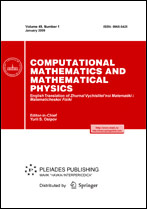|
Local algorithms for minimizing the force field for 3D representation of macromolecules
A. S. Anikina, O. A. Bol'shakovab, A. V. Gasnikovcd, A. Yu. Gornova, T. V. Ermake, D. V. Makarenkoc, V. P. Morozove, B. O. Neterebskiie, P. A. Yakovleve
a Matrosov Institute for System Dynamics and Control Theory of Siberian Branch of Russian Academy of Sciences
b University of Science and Technology "Sirius"
c Moscow Institute of Physics and Technology (State University)
d Institute for Information Transmission Problems of the Russian Academy of Sciences (Kharkevich Institute)
e BIOCAD, St-Petersburg
Abstract:
The majority of problems in structural computational biology require minimization of the energy function (force field) defined on the molecule geometry. This makes it possible to determine properties of molecules, predict the correct arrangement of protein chains, find the best molecular docking for complex formation, verify hypotheses concerning the protein design, and solve other problems arising in modern drug development. In the case of low-molecular compounds (consisting of less than 250 atoms), the problem of finding the geometry that minimizes the energy function is well studied. The minimization of macromolecules (in particular, proteins) consisting of tens of thousands of atoms is more difficult. However, a distinctive feature of statements of these problems is that initial approximations that are close to the solution are often available. Therefore, the original problem can be formulated as a problem of nonconvex optimization in the space of about ${{10}^{4}}$ variables. The complexity of computing the function and its gradient is quadratic in the number variables. A comparative analysis of gradient-free methods with gradient-type methods (gradient descent, fast gradient descent, conjugate gradient, and quasi-Newton methods) in their GPU implementations is carried out.
Key words:
energy minimization, homological folding, fast gradient descent, conjugate gradient method, limited-memory Broyden-Fletcher–Goldfarb–Shanno (LBFGS), parallel computations, Graphical Processing Unit (GPU).
Received: 08.10.2018
Revised: 15.07.2019
Accepted: 05.08.2019
Citation:
A. S. Anikin, O. A. Bol'shakova, A. V. Gasnikov, A. Yu. Gornov, T. V. Ermak, D. V. Makarenko, V. P. Morozov, B. O. Neterebskii, P. A. Yakovlev, “Local algorithms for minimizing the force field for 3D representation of macromolecules”, Zh. Vychisl. Mat. Mat. Fiz., 59:12 (2019), 2060–2076; Comput. Math. Math. Phys., 59:12 (2019), 1994–2008
Linking options:
https://www.mathnet.ru/eng/zvmmf10997 https://www.mathnet.ru/eng/zvmmf/v59/i12/p2060
|


|





 Contact us:
Contact us: Terms of Use
Terms of Use
 Registration to the website
Registration to the website Logotypes
Logotypes








 Citation in format
Citation in format 